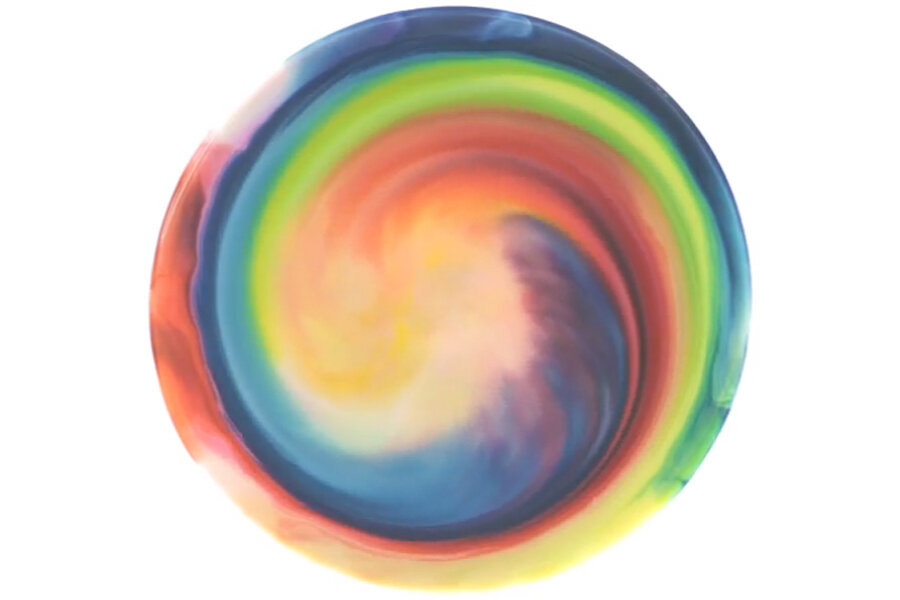Kitchen science: The secret colors in milk, fire, and black markers
Loading...
Did you know your milk could get a little psychedelic? And we don’t mean when you leave it out of the refrigerator a little too long.
All you need is a little food coloring, two kinds of dish soap, and a couple tiny rocks, and your milk turns into tie-dye worthy of Woodstock. In fact, there are hidden rainbows all around us, as long as you have the curiosity (and chemicals) to bring out the color.
Here are a few ways to bring ROYGBIV into your everyday life, plus a look at the science behind these kaleidoscopic experiments.
Molecular milk movement
Whole milk can take on some very different shades if you know what to mix with it. Put some whole milk in a Petri dish or pasta plate, and place a few drops of different food coloring on top. Then add a small dollop of dish soap. You’ll see the food coloring swirl and mix before your eyes, like spin art without the annoying whirring noise. You can create different patterns and mixtures by dipping a Q-tip or small rocks in the liquid dish soap then setting them in the milk dish, or by sprinkling powdered dish soap over the food coloring.
In this experiment, the color actually has very little to do with the actual science, but is key to showing what goes on. The food coloring shows the movement of the reaction between soap and milk, first as the soap breaks the surface of the milk, then as the soap molecules bond with the fats and proteins. The reaction can go on for 3-5 minutes.
Yellow yule log?
Christmas colors are traditionally red and green, but you can actually make your outdoor yule log pretty much any color you want with the right added chemicals. Once you get your log burning, sprinkle any of these chemicals in the flame to bring a little color to your holiday. (Add the chemicals one at a time – no need for any surprise science discoveries in the form of singed eyebrows.)
Potassium nitrate will bring out a purple flame. Barium nitrate turns flames a light green, while borax brings more of an emerald hue. Copper chloride creates a blue fire and table salt will turn the flame bright yellow. To create a longer colored flame, dissolve the chemical in a bit of water and soak a small fire starter, such as pine cones, in the mixture. Throw those on the fire, and you’ll get a longer colorful flame.
Each of these shows off the reaction between the heat and these metal salts. Essentially, being put in heat makes the electrons pretty excited, so they release energy in the form of light to get them back to a calmer state. Different metals put out different light, hence different colors. A word of caution: if you attempt this colorful experiment, do it outside. Also, do not cook over a colored flame. The chemicals can give off some unhealthy fumes, and need to be properly ventilated for you to stay safe.
Black magic … marker
A black marker is black in color, right? May sound like a silly question, but an easy experiment can actually flip the obvious answer on its head. Take a black magic marker and draw a dot in the middle of a white coffee filter or paper towel. Put a few drops of water on the circle, and watch as the color begins to spread to the edge of the paper. You’ll see the black color turn into a rainbow of different colors as it creeps toward the edge.
Though black is usually known as the absence of all color, when it comes to creating a marker, it is actually made of pigments of all colors mixed with black ink. When water is added to the mix, the pigments separate from the ink and will show up on the paper.
Bleach bummed
Had enough with all the color? There’s an experiment for that too. Fill a plastic cup with 3/4 cup of tap water, then mix in one or two drops of food coloring. Quite a lovely bright color, right? Then take another plastic cup and fill it with 1/4 cup of bleach. Combine the two cups of liquid together by carefully pouring the mixture back and forth between the cups a few times, then let it settle. After a few minutes, most of the initial color will be gone.
This experiment lets you see bleach in action. Bleach is an oxidizer, which means it can break apart the molecules in dye. When those molecules separate, they stop absorbing light, which means the color fades from view. Bleach can also reduce, which means it turns the molecules from double bonds into single bonds, rendering the molecules entirely unable to absorb light.






